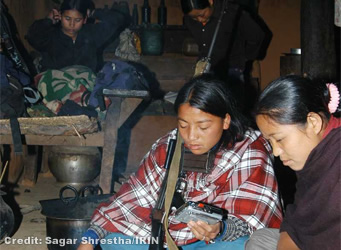|
 |
Child
soldiers in Nepal |
|
|
|
Interview
on demobilisation of child soldiers
|
 |
KATHMANDU,
9 Aug 2006 (IRIN)
Rights
groups are concerned that the government and Maoists have failed to address
the demobilisation, disarming and reintegration (DDR) of hundreds of child
soldiers during Nepal's peace process.
The
use of child soldiers - some kidnapped from their villages - during the
decade-long conflict has been widely documented but there are few detailed
figures. Watchlist, a New York-based NGO that monitors the use of children
in armed conflicts, said anecdotal evidence suggested the practice was
widespread in Nepal.
 |
| The
use of child soldiers - some kidnapped from their villages - during the
decade-long conflict has been widely documented but there are few detailed
figures. Watchlist, a New York-based NGO that monitors the use of children
in armed conflicts, said anecdotal evidence suggested the practice was
widespread in Nepal.
Sandra
Beidas, a child soldier expert and head of the protection section in the
United Nation's Office of the High Commissioner for Human Rights (OHCHR)
in Nepal's capital, Kathmandu, wants children removed from the conflict
immediately. |
|
QUESTION: Both sides in the peace talks have yet to make any commitment to the removal
of child soldiers from their respective armed forces. Is it time to start
the DDR process for child soldiers?
ANSWER: Removing children from any type of activities linked to the armed conflict
is essential and should not be dependent on any adult DDR process, peace
talks, peace agreements or cessation of hostilities. The recruitment and
use of any children under 18 is against international child rights principles.
It is important that all parties remember to include child rights in any
agreements, codes of conduct and programmes linked to the peace process.
 |
| Young female Maoists seeking refuge in a poor farmer's house. The family
feels uncomfortable about their presence - they fear the reaction of the
security forces if they find out that the family has sheltered rebels.
In
this context, there have been initiatives in Nepal during the past years
to provide care for children who were either released by the parties to
the conflict, captured or who simply voluntarily left. Some children were
provided temporary shelter, others were given legal assistance when found
to be held illegally in detention. Family tracing and mediation were also
carried out to allow for the safe return of such children to their families. |
|
However,
a national process to separate children from armed groups and return them
to their communities has yet to be set up. It should be noted that children
playing any kind of role in a military group, whether or not armed, should
benefit from such a process.
Q:
Can the UN play a role in guiding both sides in the conflict to take on
board a child-DDR process?
A:
OHCHR is playing a role in advocating for the prevention of the recruitment
and use of children in armed conflict, for the release of children and
for putting in place programmes to support children leaving armed groups.
One
of the ways recruitment and use of children can be prevented in the future
is including provisions in the constitution banning such recruitment
into
armed forces and groups, and also introducing legislation which makes it
a criminal offence.
In
addition, the UN has started discussing with both parties to the conflict
the issue of children and armed conflict. The UN country team has set up
a task force to report to the [UN] Security Council Working Group established
under UN SCR 1612 (2005), to better understand the scope of the violations
against children and to generate practical proposals for actions for state
and non-state entities.
Q:
What else needs to be done?
A:
Advocacy efforts are extremely important to continue to raise awareness
of this issue. Separating children from armed groups is essential in terms
of their protection and allowing them to return to a normal life. This
advocacy must not only be directed at the parties to the conflict, but
also civil society and the communities to which children will return, in
order to facilitate their reintegration.
Q:
Maoist leaders often deny using child soldiers, but evidence suggests that
they are widely deployed by the rebels. How can we have a child DDR process
if the protagonists refuse to come clean on this?
A:
Establishing a dialogue with armed parties to a conflict is always the
first step towards planning for the withdrawal of children. Contacts at
all levels need to be strengthened to ensure a fruitful dialogue and explore
the best ways the children can be protected and can safely return to their
communities and families.
Credit
IRIN 2006
Copyright
© UN Office for the Coordination of Humanitarian Affairs 2006
[
This report does not necessarily reflect the views of the United Nations]
Integrated
Regional Information Networks (IRIN), part of the UN Office for the Coordination
of Humanitarian Affairs (OCHA). |
 |
| Links |
 |
 |
 |
External
links |
|





